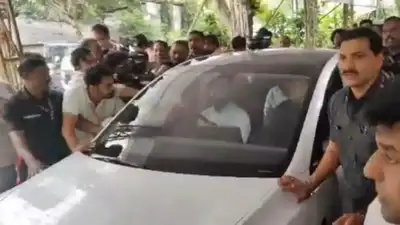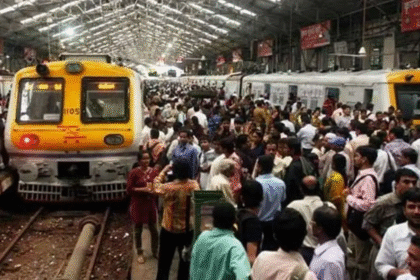Eknath Shinde Steers the Future as Tesla Roars into Mumbai
A Symbolic Start to India’s Electric Future
On a vibrant Mumbai morning thick with anticipation, Maharashtra Chief Minister Eknath Shinde did something that instantly made headlines—he slid behind the wheel of a gleaming Tesla and took it for a spin. The location? Tesla’s newly launched showroom in the heart of India’s financial capital. The moment wasn’t just a PR spectacle; it was an electrifying statement of intent.
As India’s most dynamic metropolis opened its doors to one of the world’s most iconic EV makers, the event marked a watershed moment in the country’s transition to sustainable mobility. This wasn’t merely a ribbon-cutting—it was a power move, perfectly blending politics, technology, and symbolism.
Why Eknath Shinde’s Test Drive Matters
Shinde’s decision to personally test drive the Tesla was layered with meaning. Not just a ceremonial gesture, it was a demonstration of confidence in cutting-edge green tech and a show of state-level support for global innovators looking to make India their next big market.
In front of flashing cameras, Shinde’s short ride became a metaphor for acceleration—of progress, policy, and perception. It told a story: that Maharashtra, and India by extension, isn’t merely catching up with the global EV race—it’s claiming pole position.
Tesla’s Calculated Mumbai Entry
Tesla’s Mumbai debut has been a long time coming. The EV giant, led by tech visionary Elon Musk, had been flirting with Indian markets for years, teasing fans with tweets, trade rumors, and transport ministry statements. Now, with a premium showroom unveiled in the country’s western powerhouse, Tesla’s India vision finally has a tangible form.
Located strategically to appeal to Mumbai’s elite, corporates, and auto enthusiasts, the flagship showroom combines minimalistic aesthetics with raw technological charm. Sleek charging bays, interactive displays, and an inviting test-drive track—all signal that Tesla’s India journey is set in motion.
Electric Vehicles in India: From Policy to Pavement
India’s EV revolution is no longer on the horizon—it’s here, rolling quietly through city streets. With rising fuel costs, climate pressure, and global trends aligning, the Indian government has rolled out a suite of incentives under its FAME (Faster Adoption and Manufacturing of Hybrid and Electric Vehicles) scheme. From tax rebates to R&D support, the climate for clean vehicles has never been more favorable.
Eknath Shinde’s drive wasn’t an isolated media stunt—it was a continuation of state policy. Maharashtra has been aggressively positioning itself as a hub for EV innovation, offering land subsidies, infrastructure fast-tracking, and corporate tax incentives to electric mobility companies.
The Message Behind the Wheel
When Shinde gripped the steering wheel of a Tesla, it was a visual message to global investors: “We’re ready for business. We’re driving change.”
The CM’s move also aligned with India’s larger narrative—one that aims to position the country not just as a consumer of green technology but as a manufacturer and exporter of it. With Gigafactory whispers, software integration opportunities, and a fast-maturing consumer base, Tesla’s Mumbai stop may be just the beginning of a deeper engagement.
Would you like me to continue with Part 2? This would cover topics like:
- Tesla’s India strategy in depth
- Mumbai’s EV infrastructure rollout
- How this event resonates with India’s global image
- A profile on Eknath Shinde’s tech-forward governance
- Public reaction and social media analysis
- Industry impact: What Indian EV startups are saying
- Economic implications and investor outlook
- Comparative insights with other global Tesla launches
Tesla’s Grand Vision for India: More Than Just a Showroom
The newly opened Tesla showroom in Mumbai is not just a retail outlet—it’s a symbolic outpost of a global movement. For Tesla, India represents more than a market of over 1.4 billion people. It’s a future manufacturing hub, a tech innovation pool, and a sustainable mobility partner in Asia’s clean energy transition.
Behind the cameras and ceremonial test drives, Tesla’s strategic thinking is visible in subtle but calculated moves. Its Mumbai launch is a soft-power introduction, designed to build brand equity in a nation that’s still warming up to premium electric mobility. The goal? Market seeding. Relationship building. Ecosystem alignment.
In short, Tesla isn’t just selling cars—it’s selling a future.
Why Mumbai? A Strategic Springboard
Tesla’s decision to plant its first flag in Mumbai isn’t accidental. Maharashtra offers everything a global EV brand needs to thrive:
- Financial muscle: Mumbai is the richest city in India with the highest number of High Net-Worth Individuals (HNIs).
- Infrastructure readiness: With a growing number of EV charging stations, expressways, and clean energy investments, the city is EV-ready.
- Political support: A state government that actively courts technology and manufacturing giants.
With Maharashtra CM Eknath Shinde taking the lead by test-driving a Tesla, the signal is unmistakable—the state wants to be Tesla’s Indian HQ, not just a sales destination.
From Curiosity to Conversion: India’s Evolving EV Market
India’s EV landscape is undergoing a transformation at warp speed. While budget-conscious electric scooters and affordable e-rickshaws have dominated the early wave, a second surge is now underway: one led by luxury, performance, and global prestige.
Tesla’s arrival appeals to this aspirational middle and upper class who are no longer content with petrol guzzlers. They want green status symbols—and Tesla delivers both sustainability and speed.
Some key trends backing this shift:
- Urban adoption rising: Delhi, Mumbai, and Bengaluru lead the EV registration charts.
- Public infrastructure upgrades: Ultra-fast chargers are being deployed along highways and urban clusters.
- OEM competition: Brands like Tata, Hyundai, MG, and BYD are all upping their game, indirectly preparing the market for Tesla’s scale play.
Tesla’s Mumbai launch, therefore, is well-timed—it rides the wave of interest and redefines the Indian EV dream.
The Eknath Shinde Factor: Why the CM’s Drive Matters Politically
CM Eknath Shinde’s Tesla drive may seem like a media-friendly gesture, but it’s also a political masterstroke.
By aligning himself with a tech-forward brand, Shinde is crafting a modern, development-centric image that appeals to Maharashtra’s youth, entrepreneurs, and investors. It speaks to a techno-political narrative: less bureaucracy, more acceleration. Less red tape, more rollout.
In a state where governance optics matter, Shinde’s Tesla moment is more than a photo-op—it’s brand Maharashtra 2.0.
Public Reaction: Social Media Ignites
The news of Eknath Shinde driving a Tesla in Mumbai exploded across social media platforms:
- Twitter was abuzz with hashtags like #TeslaInMumbai, #ShindeInTesla, and #EVIndia.
- Instagram reels showcased video snippets of the CM driving, prompting curiosity and excitement.
- LinkedIn posts by tech entrepreneurs praised the move as a sign of “New India welcoming global innovation.”
The digital buzz has translated into real footfalls, with people flocking to the showroom just to experience a Tesla up close.
Industry Reactions: What India’s Auto Giants Are Saying
While public excitement is high, auto industry insiders are cautious but alert. Companies like Tata Motors and Mahindra, which have invested heavily in their own EV platforms, now see Tesla as both a threat and a benchmark.
An anonymous executive at a leading Indian auto firm remarked:
“Tesla’s presence forces all of us to level up. It’s not just about EVs now—it’s about software, experience, and ecosystem.”
In this competitive cauldron, Tesla’s entry could actually galvanize domestic innovation, pushing the whole sector into high gear.
Tesla’s Ecosystem Bet: Charging Infrastructure, Service & Localisation
To truly succeed in India, Tesla knows it must go beyond cars.
- Charging Infrastructure: Tesla has begun exploring partnerships with Indian firms to roll out Supercharger stations across Mumbai, Pune, Bengaluru, and Delhi.
- Service Model: Expect a tech-enabled, app-first service network where diagnostics, maintenance, and upgrades happen with minimal human interaction.
- Local Manufacturing: With rumors of a Tesla Gigafactory in Gujarat or Maharashtra still hot, Tesla could soon go from import to “Make in India.”
That shift will not just reduce prices—it will supercharge India’s EV supply chain, from battery cells to AI chips.
A Billion-Dollar Prize: Who Will Host Tesla’s First Indian Gigafactory?
As Tesla’s iconic showroom launch in Mumbai steals the spotlight, a behind-the-scenes political race is quietly intensifying—a high-stakes tug-of-war between Maharashtra and Gujarat to secure Tesla’s much-hyped first Indian Gigafactory.
The implications are massive:
- Thousands of direct and indirect jobs
- Billions in foreign direct investment (FDI)
- Access to the global EV supply chain
- A tech ecosystem ripple across startups and infrastructure
While Tesla remains officially tight-lipped, senior bureaucrats in both states have confirmed multiple rounds of talks with Tesla representatives. The prize is nothing short of transformational—and both state governments are going all-in.
Maharashtra’s Pitch: Legacy, Infrastructure, and Urban Leverage
Following CM Eknath Shinde’s symbolic Tesla test drive, Maharashtra is building a narrative of readiness and reliability.
Key selling points include:
✅ Established Auto Corridor: Pune, Nashik, Aurangabad, and Mumbai form a formidable base with existing auto giants like Tata, Mahindra, Mercedes-Benz, and Bajaj.
✅ Ports and Logistics: Mumbai’s proximity to JNPT (India’s largest container port) gives Tesla global export leverage.
✅ Skilled Talent Pool: With IIT Bombay and top-tier engineering institutes nearby, Tesla would have easy access to high-quality R&D talent.
✅ Political Signaling: Shinde’s public ride was also a signal to Elon Musk: “We’re serious—and visible.”
Behind closed doors, top Maharashtra officials are offering Tesla land at subsidized rates, power at industrial tariffs, and a red-tape-free zone.
Gujarat’s Counterpunch: Proven Track Record and Political Muscle
But Gujarat isn’t watching silently. With a pro-business reputation built under PM Modi’s former leadership, Gujarat has already hosted massive projects like:
- Tata Nano (Sanand)
- Maruti Suzuki’s manufacturing base
- Foxconn’s proposed semiconductor fab
Now, Gujarat is pitching itself as Tesla’s no-nonsense launchpad, offering:
✅ Large contiguous industrial land
✅ Plug-and-play ecosystem near Dholera Special Investment Region (SIR)
✅ Policy certainty and bureaucratic speed
✅ Strong central backing—a subtle advantage Tesla can’t ignore
Sources close to the Gujarat Industrial Development Corporation say that Elon Musk’s team has visited at least two locations, including one near Sanand.
Elon Musk’s India Strategy: From Cryptic Tweets to Concrete Talks
Tesla CEO Elon Musk has long teased Indian fans with cryptic tweets:
“India has great potential for sustainable energy.”
“We want to enter India but face many challenges.”
“Talks are ongoing with Indian leadership.”
Behind the social media fog, there’s substance. In June 2023 and again in early 2025, Musk held virtual discussions with Indian ministries, exploring:
- Import duty relaxations
- Policy alignment for EVs and solar infrastructure
- Data regulations for Tesla’s in-car systems
In the latest meetings, Musk’s conditions included:
- A phased rollout plan
- Local sourcing targets
- A 100% foreign-owned manufacturing entity (without Indian joint ventures)
India, in turn, has reportedly agreed to lower import duties for EVs if Tesla commits to local manufacturing within a defined time frame.
Barriers on the Road: Challenges Tesla Must Navigate in India
Despite the momentum, Tesla’s road in India won’t be smooth.
🚫 Import Duties
India imposes a 60% to 100% import duty on fully built cars, making a Tesla Model 3 cost nearly ₹60–70 lakhs—out of reach for most buyers.
⚡ Charging Grid Gaps
While metro cities like Mumbai and Bengaluru are catching up, India’s pan-India charging infrastructure is fragmented and underpowered.
🧠 Consumer Mindset
The Indian car buyer is cost-sensitive, value-driven, and mileage-conscious. Tesla will need to educate the market about long-term savings, reliability, and environmental benefits.
🛠️ Service & Parts Ecosystem
Tesla’s “no dealership” model requires a robust online ecosystem, predictive servicing tech, and spare parts logistics, all of which are still under development in India.
What a Gigafactory Means for India’s EV Future
If Tesla finalizes its Indian Gigafactory, the impact will be seismic:
- EV battery production localization
- Upstream supply chain boost (metals, electronics, AI)
- Exports to Southeast Asia, Europe, and the Middle East
- Stimulus to Indian EV startups and ancillary players
- Massive employment for engineers, logistics, technicians, and designers
In short, it will turbocharge India’s EV dream and elevate its status from a market to a global manufacturing player.
Voices from the Industry: Anticipation and Anxiety
“If Tesla chooses India, we expect a second industrial revolution in auto manufacturing,”
said Sandeep Verma, a mobility analyst at EY India.
But not everyone is cheering.
“The fear is that Tesla might monopolize EV mindshare,”
said a senior executive from an Indian EV startup.
“We hope it grows the market for all, not crush local players.”Blueprint of a Revolution: Tesla’s Indian Manufacturing Timeline
After years of speculation and global anticipation, Tesla is now drafting a serious roadmap for localized manufacturing in India—a decision poised to redefine not just the company’s presence in Asia but also India’s place in the global EV supply chain.
According to senior sources within India’s commerce and heavy industries departments, Tesla has laid out a three-phase plan:
🔹 Phase 1: CKD/SKD Assembly Line Setup
Tesla may begin by importing completely knocked down (CKD) or semi-knocked down (SKD) units and assembling them in India to test cost viability and volume expectations.
🔹 Phase 2: Mid-Scale Factory and Component Localization
Within 2–3 years, the company plans to build a mid-scale plant, initially focused on body panels, battery packs, and select drivetrain components, involving local vendors and joint R&D labs.
🔹 Phase 3: Full-Scale Gigafactory
Once policy, sales, and supply chains align, Tesla aims to commission a full-fledged Gigafactory—with battery cell production, AI integration labs, and export-oriented manufacturing—all Made in India.
This phased entry ensures risk control while signaling commitment to long-term investment.
Can India’s EV Supply Chain Handle Tesla?
This is the million-dollar question—and the answer is evolving fast.
🏭 Component Manufacturing
India’s auto parts industry is massive but petrol-diesel centric. EV-specific parts like high-density lithium-ion battery modules, magnet-based motors, and advanced software chips are still largely imported.
🔋 Battery Supply Constraints
India has no commercial-scale lithium mining or battery-grade refining units. Tesla may need to import raw materials from Australia, South America, or China—unless India accelerates its National Battery Mission.
🤝 Supplier Ecosystem Readiness
Local startups like Exide, Amara Raja, Ola Cell Technologies, and Tata Agratas are in the early stages of developing EV-specific gigafactories and component ecosystems. Tesla could either partner with them—or outpace them.
The opportunity here is huge: Tesla’s entry could catalyze the rapid maturation of India’s entire EV supply web, making it more competitive, collaborative, and globally integrated.
Beyond Vehicles: Tesla’s Data, AI & Autopilot Challenge in India
Tesla is not just an automobile company—it’s a software and AI firm on wheels. Its vehicles are embedded with Autopilot systems, neural networks, real-time diagnostics, and over-the-air updates. But that’s where India’s data landscape becomes a sticking point.
🔒 India’s Data Protection Laws
With the Digital Personal Data Protection Act (DPDPA) 2023 in force, Tesla must store user data locally and comply with strict rules on biometric and vehicular telemetry.
🤖 Autopilot in Indian Traffic?
While Autopilot performs seamlessly on wide Californian roads, India’s chaotic and unstructured traffic is a whole different game. Tesla will need custom training of its AI models—something it can only do through long-term, on-ground testing and policy collaboration.
Tesla might eventually launch a “Tesla India Vision Lab”—a local AI center to re-train its autonomous systems for Indian environments.
India vs China: The Geo-Economic EV Chessboard
Tesla’s deepening ties with India come at a time of growing geopolitical friction with China, where regulatory hurdles, censorship issues, and data concerns have made foreign companies uneasy.
India is capitalizing on this:
- Open tech policy, with freedom for companies to bring their software and design IP.
- Geopolitical alignment with Western democracies, making India a safer long-term bet.
- Market democracy—while China imposes quotas and subsidizes local brands, India allows a free-for-all competition, with Tesla, BYD, Tata, Hyundai, and MG competing on merit.
In essence, India is now the preferred frontier for Tesla’s Asian ambitions—less risk, more upside.
The Young Indian Buyer: Tesla’s Next Brand Army
India’s 600-million-strong youth demographic is digital-first, brand-conscious, and planet-aware.
Here’s what Tesla means to this generation:
- Status Symbol: Driving a Tesla is the new-age iPhone moment—a blend of design, purpose, and aspiration.
- Environmental Statement: For a generation marching for climate justice, Tesla is more than a car—it’s a commitment to clean air.
- Tech Fascination: With its voice-activated controls, smartphone-linked dashboards, and real-time updates, a Tesla feels like a gadget on wheels—perfectly aligned with Indian Gen Z and millennials.
Tesla may not dominate in numbers initially, but it will dominate in influence—and that’s how cultural footholds are formed.
Marketing the Future: Tesla’s India Positioning Strategy
Without ads, without dealerships, and without media blitzes, Tesla still generates buzz. But for India, it will need a localized emotional connection.
Strategies under consideration:
- Influencer-driven test drives
- YouTube documentaries on “Tesla in India”
- Hindi, Marathi, and Tamil UI options
- A “Desi Tesla” customization campaign for interiors and themes
Expect Tesla to co-create brand value with Indian creators, engineers, and environmentalists, not just marketers.
Final Word: The Drive Has Just Begun
From one powerful spin in Mumbai to whispered talks of a Gigafactory, Tesla’s India saga is a masterclass in strategic entry—slow, smart, and story-driven.
Eknath Shinde’s drive was more than a spectacle. It was a spark. What follows is a movement.
🟢 Coming Up in Part 5:
- Tesla and India’s startup ecosystem: partnerships, mentorships, and capital links
- How Tesla’s presence could shift India’s education and engineering priorities
- Deep dive into Tesla’s sustainability impact: carbon offsets, clean energy credits
- Opposition voices: What critics and environmental watchdogs are warning
- The roadmap to Tesla’s mass-market India car—priced under ₹25 lakhs?
Also Read : Israel-Syria Tensions Escalate: 5 Urgent Reasons Behind Israel’s Bombing Campaign in Syria







